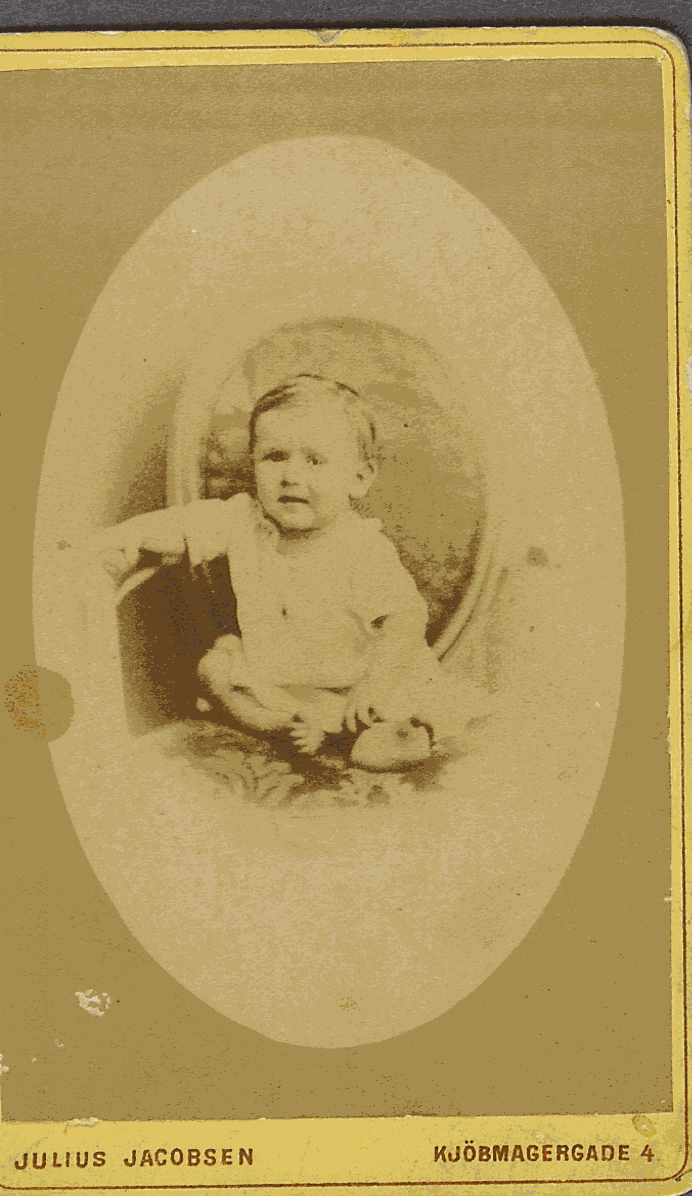
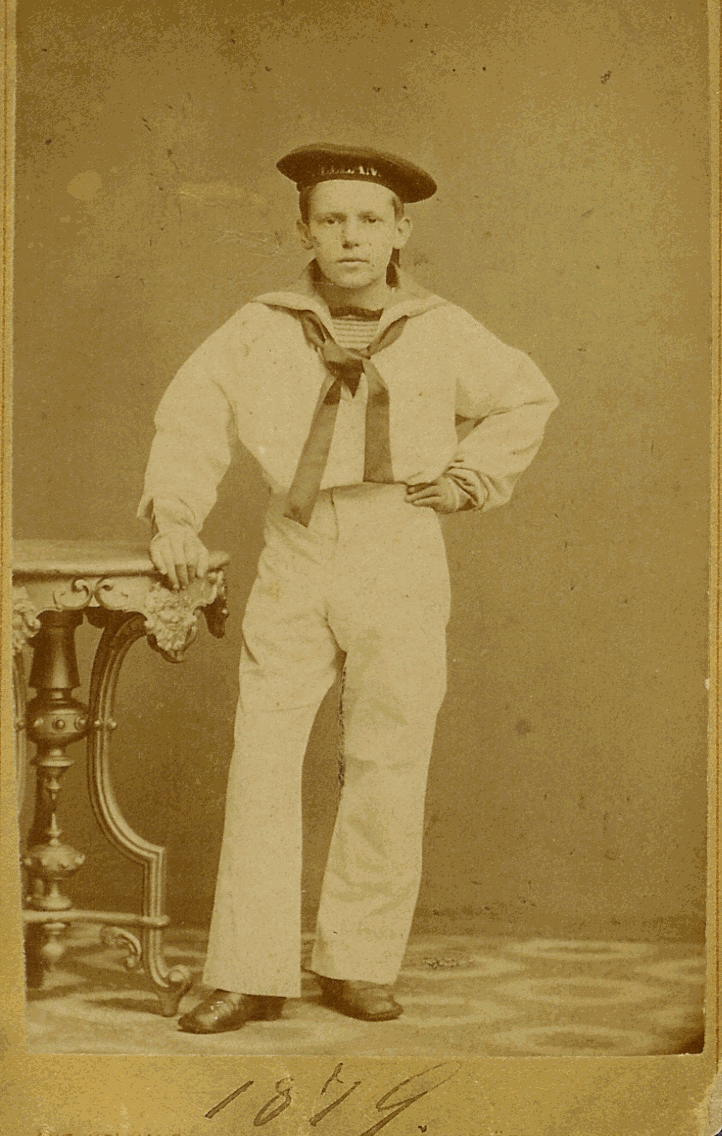
Surely no young boy ever grew up with a more interesting set of grandfathers than I had. While they respected and enjoyed each other immensely, they were rather extreme opposites.
My fatherís father was born in Copenhagen, Denmark Sept. 1st, 1864. He was christened Lajos Michael Amadeus Proschowsky. Now, thatís a mouthful! His father, Anton, was Taylor to the King of Denmark, and a successful businessman. He guaranteed a loan for a ship that was to bring goods from the Far East. The ship was reported to be headed north off the coast of Portugal, but never arrived in Copenhagen. The Proschowsky family was suddenly in financial trouble, so Lajos decided to sign onto a merchant sailing ship as cabin boy, in order to lighten the load for his father. He was 12 or 13 years old at the time. While he was in school, he was taught English and French, as well as some music.


Dad, as a Baby Dad, age 15
At age 16, he returned to Denmark to do his mandatory service in the Danish Navy, two years, I think. Returning to a Merchant Ship, he earned the rank of Able Seaman. He became the Ships Carpenter and Sail maker. He sailed twice around Cape Horn, the southern tip of South America. Those waters were considered to be among the most dangerous in the world.
Sometime during his years at sea, he changed his name to Robertson. I really donít know the reason for this, but what I do know is that an older brother had already changed his name to Robertson. Lajos easily morphed into Luis, and thus my grandfather, Luis Robertson. As children, we always addressed our parents by their first names, Tom and Dorothy. So, since our father called his father "Dad", we did the same. He was always Dad to us.
My motherís father, Charles Edward Utt, was born May 23, 1866, in Auburn, Placer County, CA. His father, Lysander Utt, came to CA during the gold rush of 1849. He worked at hauling freight from Independence, Missouri, with oxen and wagons. He also worked at mining, and when that failed he hauled firewood and other supplies for the newly built Railroad. In 1874 the Utt family moved to Tustin, CA. The trip, by team and wagon, took 30 days. C.E Utt was always "Grampa" to us.
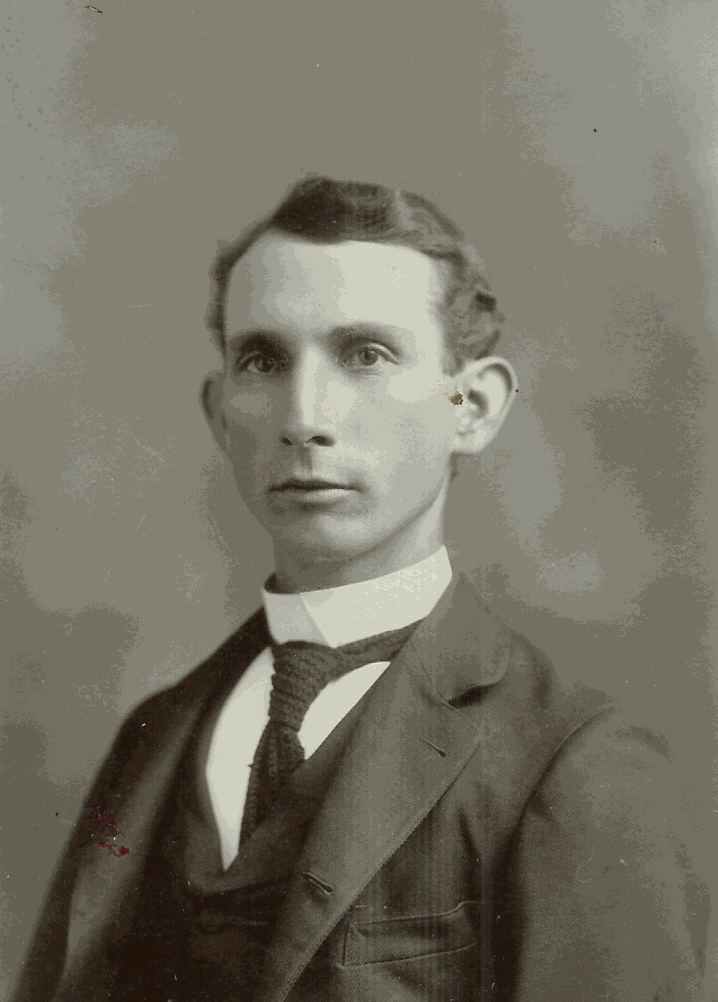
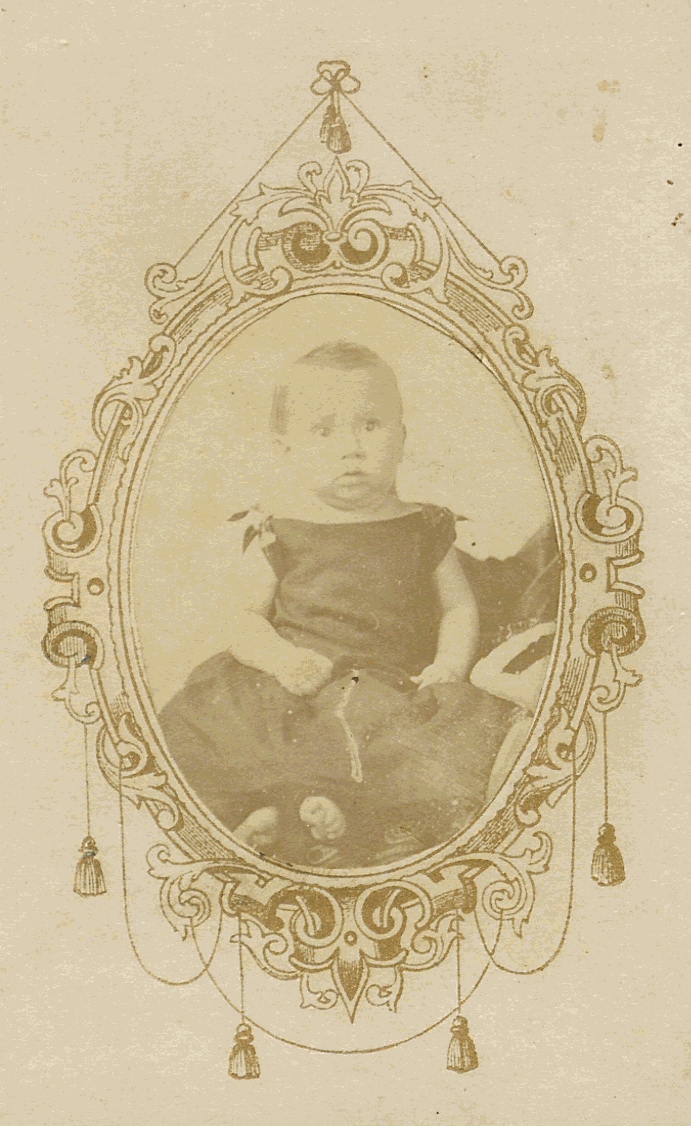
Charles Edward Utt
When the Utt family arrived in Tustin, the town consisted of one rather large building, a small store, a small blacksmith shop, a small school and some scattered, crude, huts. The only farmer on the San Joaquin Ranch (Irvine Ranch) was Grampaís Uncle Charles Platt. All the rest of that huge ranch was used only for grazing cattle and sheep. Lysander and Arvilla Platt Utt purchased the small store, and living quarters above. Grampa went to school, and helped out in the store. He also found a nurseryman, and made a deal to work for him, and to receive his pay in the form of an orange tree, which he planted in the back yard. That tree proved to be the first of hundreds of thousands, if not millions, of trees that he was in some way responsible for planting during his lifetime. (Orange, Lemon, Avocado, Walnut, Persimmon, Apricot)
At the age of nine years, he started renting small parcels of land to grow crops on. Iím not sure what these crops were; probably vegetable gardens. Grampaís father died in 1890. Grampa and his mother ran the store for another four years after that. From then on, all his effort went into farming.
When Dad was in his early twenties, he and another seaman bought their own small sailing ship, and used it to haul freight and passengers from island to island in the Caribbean Sea. A few years later they sold the ship, and went to Arkansas. One of the things they did there was to cut and shape railroad ties, from a certain kind of Oak Tree. They were paid by the piece, not by the hour. This was very hard work without any power saws!
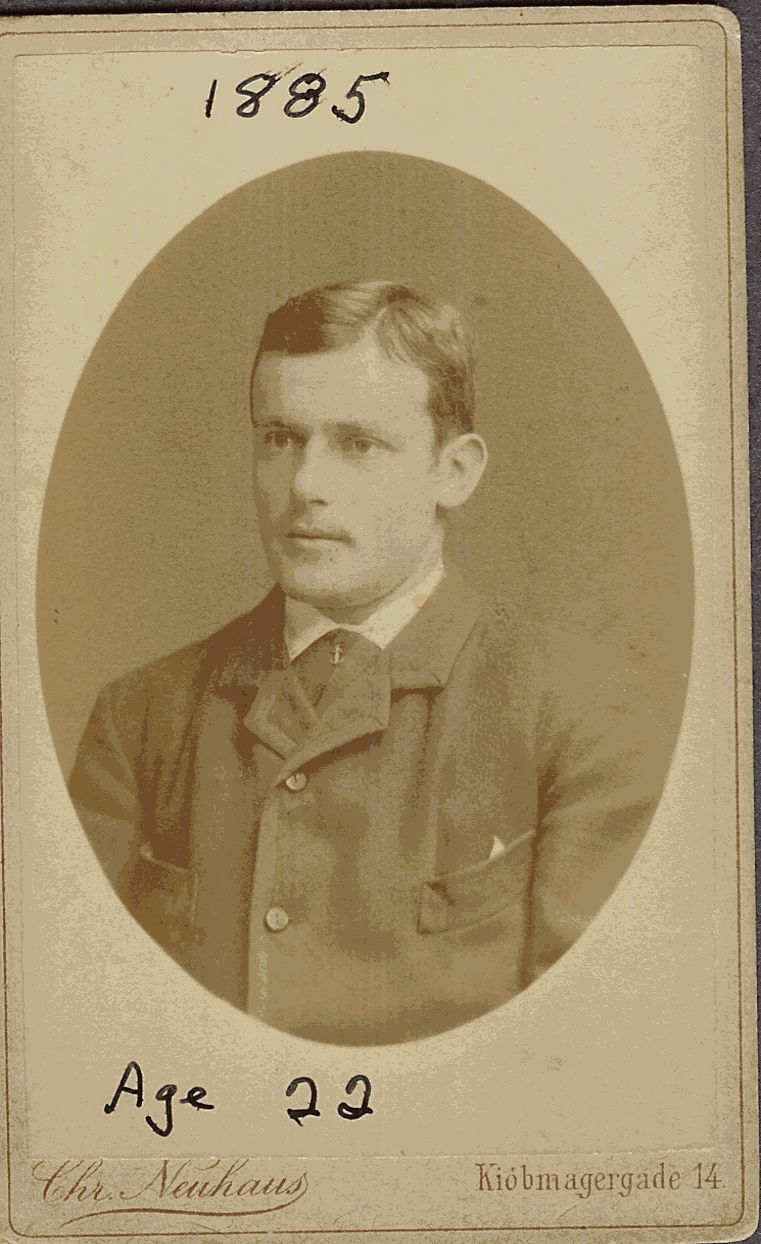
Luis, "Dad" Robertson
Photo obviously taken on a visit to his home in Denmark
From Arkansas they migrated farther north, to Wisconsin, where Dad bought and operated a small dairy. Dad read some newspaper articles about the Topolobampo Colony in the state of Sinaloa, Mexico, and decided to seek his fortune there. He sold the dairy, and headed for Mexico.
Unlike nearly all the other colonists, Dad did not travel with a group. He was completely on his own. At Guaymas, Sonora, he found the steamship "Mazatlan", that hauled passengers and trade goods to the various ports on the west coast of Mexico. He learned that the shipís captain needed a Quartermaster to complete his crew. Please donít ask me about the duties of the Quartermaster! Dad took the job, and made a deal for free passage, with the understanding that he would eventually be leaving the ship at Topo.
One of the stops on the way south left a lasting impression on Dad. In order to take advantage of the very large difference between high tide and low tide in the northern part of the Gulf of California, the Captain Took his ship, a steamer, by the way, into Bahia de Los Angeles. He positioned the ship over a flat sandy bottom at high tide. When the tide went out, all hands turned to scraping barnacles from the outer hull of the ship. I donít know how many tide changes this may have taken. Since Dadís first love was fishing, he took advantage of the high tides to do some testing of the waters of the Bay. He had fished in many places around the world, including the moat around the Kingís Castle in Denmark, but he felt that Los Angeles Bay was by far the best fishing he had ever had. My father, as he was growing up, remembered Dad talking many times about Bahia de Los Angeles, and that one day they must return to that fishermanís paradise.
Dad arrived at the Topolobampo Colony near the end of its existence, May 1892. From reading various histories of the Colony, I would hazard a guess that the great majority of those Colonists were of average or above in mentality and education, way above average in idealism, and sadly lacking in survival skills and common sense. Dad, on the other hand, was not idealistic. He had a world of common sense, and knew how to get things done. The things he didnít know, he quickly learned. He was never afraid of work.
In 1893 the Colony totally collapsed, and nearly all the colonists returned to the U.S, mostly California, I would guess. A group, including Dad, of the most industrious, most determined, (or just plain stubborn), stayed in Los Mochis. They stayed as individual farmers, not as a collective. Dad had 20 acres of land next to the irrigation canal that he farmed, and he sought other work as well. He was hired by the owner of American Sugar Company, B.F. Johnston, and soon became manager of all field operations. It was during this time that he married my grandmother, Bessie Bunker (Schellhouse) Robertson. My father, Thomas A. Robertson, was born November 22nd of 1897.
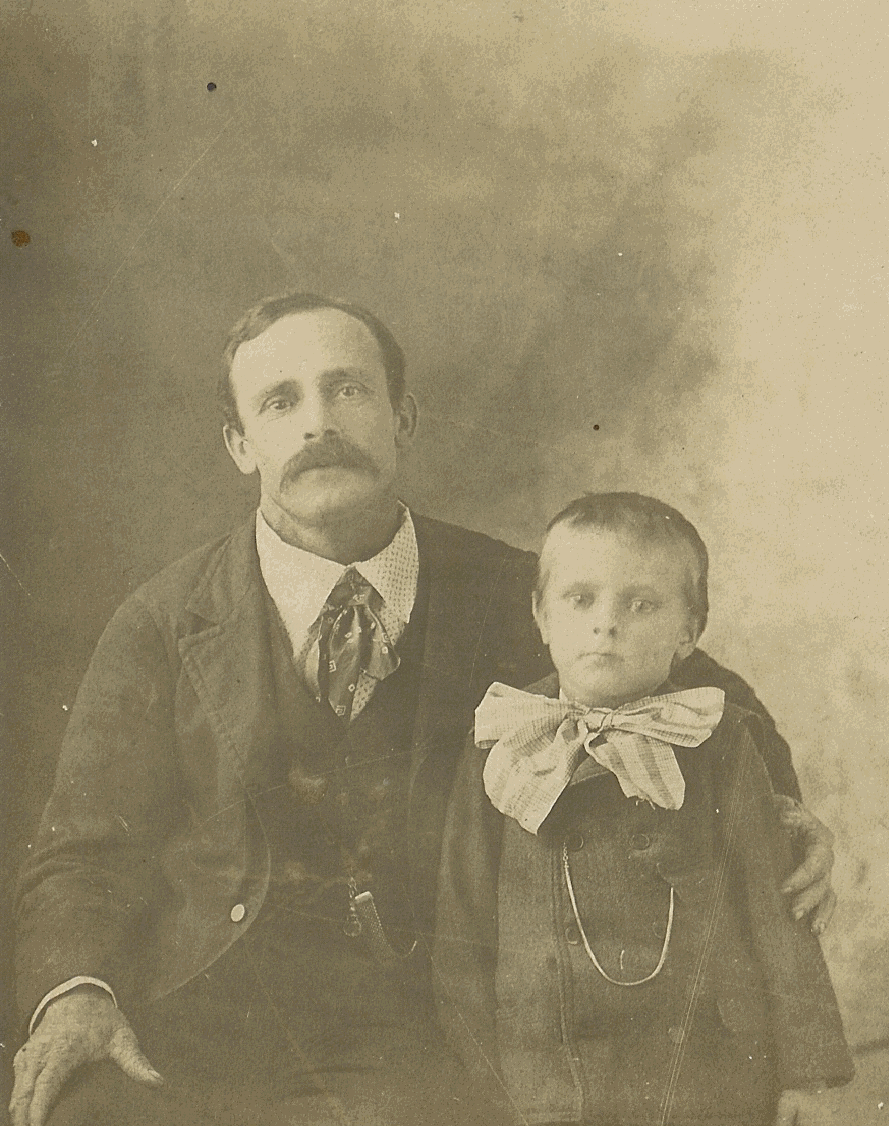
Luis Robertson and Tom Robertson
Grampa Utt married Mary Matilda Sheldon. Their second child was my mother, Dorothy Mae Utt, born July 25, 1897. I never knew my motherís mother, as she died before I was born. Grampa re-married, and his second wife was Grandma Utt to all of us.
One of Grampaís first successful farming ventures was the growing of peanuts, on land rented from the Irvine Ranch. As production and sales grew, he built his own peanut dehydrator, and packaging plant. He got an exclusive contract to sell packaged peanuts on the Santa Fe Railroad passenger trains. He was known as the Peanut King, or Goober King, take your choice. When the dehydrator burned down it was rebuilt as a pepper dehydrator. I guess Grampa felt that there was more money to be made from chili peppers than from peanuts.
In 1906, Grampa conceived a plan to turn 1,000 acres of bare land into orchards. He, and a wealthy neighbor in Tustin, Sherman Stevens, got James Irvine, Jr. to join them in this venture. The plan was to lease the land from the Irvine Ranch, also known as Rancho San Joaquin. All three of them would share the expense of planting the orchards. They incorporated as San Joaquin Fruit and Investment Co. The lease gave the Corp. the option of buying the land for a fixed price at some time in the future. This they did, and Grampa was well on his way to becoming wealthy! This threesome went on to develop several other projects. It was said that Grampa had the vision, Stevens had the money, and Irvine had the land. (The original Irvine Ranch encompassed 100,000 acres!) For reasons that I donít know, later developments were done by Utt Development Co, also incorporated. The San Joaquin Fruit and Investment Co. owned 50% of the shares in the new Company. The remaining shares were sold to others.
Meanwhile, in Sinaloa, Dad was farming and working for B,F, Johnston, and his family was growing. The Mexican Revolution raged from 1910 to 1920. The main battles were in central Mexico, but on the west coast various makeshift armies swept into Los Mochis and governed until driven out by other makeshift armies. The Americans were neutral, and mostly left alone as far as there lives were concerned. To my knowledge, only one American was killed during that time. However, mules and horses were confiscated, along with feed for the livestock and whatever else the armies needed. Each commander that came into power issued his own paper money that became worthless as soon as the next army swept in.
The U.S Government kept a navel ship in the harbor of Topolobampo. When things got too dicey, the women and children were sent to Topo, where the naval guns could protect them. In extreme cases the men also went to Topo. In one case that I know of, all the families were taken aboard ship to be evacuated to California until it was safe to go back. During the worst of times, Dad kept a small boat hidden in the Mangrove forest on the inland shore of Topolobampo Bay. It was stocked with drinking water and fishing gear, then sunk to the mud with rocks. Only he knew where it was. With water and fish he could survive for a long time. Fortunately, he never had to use it!
In 1914 my father was sent to Santa Ana, CA to go to high school, having received all the education available to him in Sinaloa. I think Santa Ana High School was chosen because several relatives, on his motherís side of the family, lived in the area. One of his classmates was Dorothy Mae Utt. When they graduated, Tom had the best grades in the class, and Dorothy was second. No wonder all of us are so smart!
I think that the two grandfathers met for the first time in 1917, while Grampa was on a trip down the west coast of Mexico. During the period of 1917-1924, Grampa made many trips to Mexico, as well as to the Pacific Northwest, Canada and Florida. He wrote extensively about these trips. All of these writings were published in the Santa Ana Register, and have been preserved on a CD titled C.E Utt Writings.
After my folks were married, Jan. 1919, Tom and Dad started farming as partners. Dad had his twenty acres, and Tom had inherited 20 acres from his grandfather, Tom Whitzell. B.F. Johnston offered to have them grow all the alfalfa hay for the mules used by the American Sugar Company, using Sugar Co. land. This was a huge undertaking. They also grew Sugar Cane, tomatoes for the U.S. winter market, and some seed crops. All together, they were farming a thousand acres, all with mules. I canít even speculate on how many mules they had, and how many harnesses, and how many mowers, and hay rakes, and wagons to haul the hay to a stationary hay baler, and how many men they had working. All the farm equipment was ordered from the catalogs of U.S manufacturers, and shipped by rail. In one of Grampa Uttís letters published in the Santa Ana Register, he remarked that the soil on the Mochis plane must surely be among the toughest to work with that he had ever seen. That meant that all the tillage tools had to be super heavy duty, and it took lots of mules to pull them. Remember, the Mexican mule was not nearly as large as the mules that were being used in the U.S.
As you might well imagine, Dad always found time for recreation. Understand, of course, that the word recreation, to Dad, meant boating and fishing! Many of the American families in Mochis had cabins at either Topolobampo Bay or, later, San Ignacio Bay, where they spent as much time as possible in the brutally hot summer. They sometimes went to Topo in handcars on the rails that had been laid from El Fuerte to Topo. Dad made the return trip easier by putting up a sail, to harness the afternoon onshore breeze.
During those years Dad had two sailboats, about thirty feet long. The first one was purchased from someone else. I donít know the time frame, or all of the people involved, but this boat was driven onto the shore by a storm, and destroyed. Dad and Tom were onboard, and surely one or two others. No one was lost. To get from Topo to San Ignacio in a boat requires going out into the open sea, and thatís where they ran into trouble.
Dad then built his own boat, which he christened "Ina", for one of Tomís sisters. Knowing what I know about Dadís seamanship, and the design of the boats that he built, I would hazard a guess that the Ina would have weathered the storm that destroyed the other boat.
The two grandfathers shared a couple of rather remarkable boating adventures. About 1925, Dad built a boat especially for a trip down the Colorado River. My first knowledge of this trip didnít come until my trip to Sinaloa in 1936. At that time this meant little to me. I knew nothing of the Colorado, and the dangers of running it, so I didnít ask any questions. By the time I became interested, there was no one alive to answer my questions.
What I know, or think I know:
At San Ignacio, in 1936, we found Dadís boat. Tomís old friend, Lino Jacobi, had been taking care of it. As I remember, it was about 10 to 12 feet long. Under each seat was an airtight metal container, for flotation in case the boat capsized, or filled with water.
I remember Tom telling me that the boat had been hauled to the river on the Sinaloa Ranch truck. That would indicate that Dad had built the boat after moving to the Ranch, which would tell me that 1925 would be about right.
Tom also related to me some of the miss-adventures they had on the river, such as Grampa getting stuck in quicksand, and Dadís fast reaction to get him out; trying to sleep at night on a narrow beach in wet clothing. My cousin, Jim Deaver is certain that they went through the Grand Canyon, but I seriously doubt that. I suspect that they started their voyage at the lower end of the Canyon. Itís a question that will never be answered. I donít quite know why the boat ended up in San Ignacio, rather than going back to the Ranch in Simi.
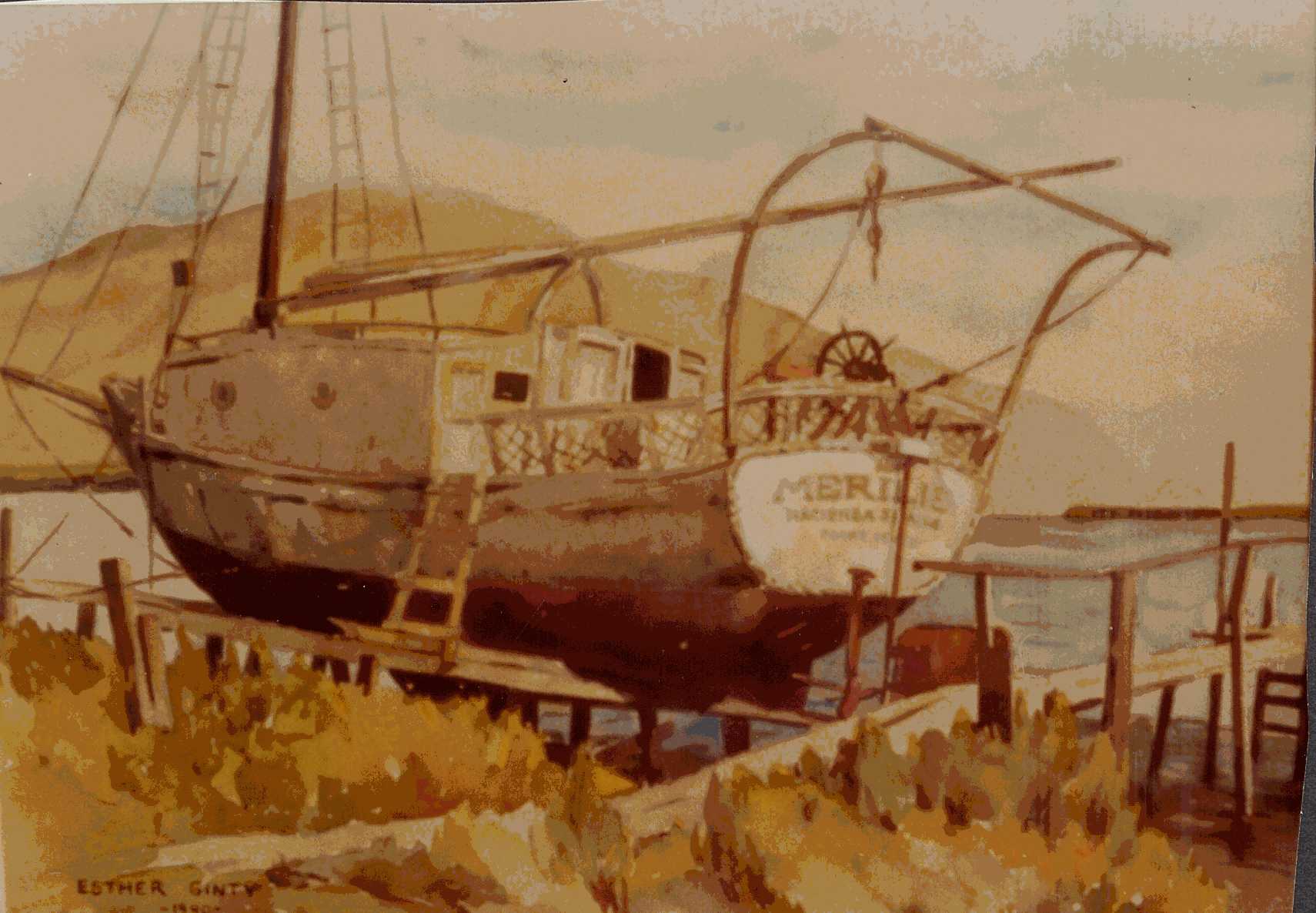
This painting
of The Merilie was done by the mother of an acquaintance of mine.
It ended up
hanging on the wall of a house built on Sinaloa Ranch.
What kind of coincidence is that?
The other trip was in the Merilie. See my short story titled The Cabin at Point Mugu. After the Merilie had been thoroughly checked out in the local waters, Dad and Grampa set out on a long voyage down the west coast of Baja. My knowledge of this trip comes from Dad telling us the story after their return. The crew consisted of two young men that, according to Dad, had little, if any knowledge of sailing. I should mention here that Dad, in general, was not critical of others. He liked everybody, and everybody liked him.
However, when it came to boating, or fishing, he could be quite judgmental. In this case he felt that Grampa and the crew were quite inept!
I only remember a few things that Dad spoke of about the trip. On their way south, they took shelter from strong winds, and high waves, in the bay of Ensenada. There was no breakwater at that time, so the high waves were coming into the bay. A Mexican Naval boat, equivalent to our Coast Guard Cutter, came out and pulled alongside to see if they needed any assistance. Dad assured them that he was fine, and the cutter returned to the tiny bit of shelter available where the shipyard is today. Dad chuckled at the fact that the waves were breaking on the deck of the Cutter, while the Merilie was riding high; He felt that the Cutter was in more danger than the Merilie!
He told us of the difficulty of getting into, and out of, Manuela Lagoon, a few miles north of Gerrero Negro. He also related a near tragedy, when one of the young men went overboard in a storm. Only Dadís quick action saved him.
As a boy and young man I recognized that this trip was quite an accomplishment. However, in the last twenty years or so, I have come to realize just how difficult it was. From reading various history books about the discovery and settlement of the Californiaís, I have learned that the Pacific Coast of the Californiaís has been a graveyard for northbound ships, of all sizes. This is one of those times that I donít understand everything I know! Some of the factors are that the cold Japanese current flows Southeasterly down the coast, so sailing North means bucking that current, and the wind, all the way. The cold current mixing with the warmer water probably accounts for some of the unpredictable storms. From looking at the map, one can see that Ensenada is the only place on the entire west coast of Baja that a boat could get shelter from a Southwest wind. Cabo Colnet, Santo Tomas, and San Quintin offer limited shelter from Northwest winds.
Terry tells me that within her memory a 90 ft. yacht set out from San Jose del Cabo for Balboa, or Dana Point, and was never seen or heard from again.
I also wonder about how Dad and Grampa managed food, water and gasoline. Food, I guess was doable; canned goods, dry beans and rice, potatoes, and all the fish they could eat. Oh yes! Dad always had lots of hardtack on these trips. For the uninitiated, hardtack, sometimes called sea biscuit, is very hard, very dry, and utterly tasteless. Its only virtue is that it will last forever. Thatís the reason it was a staple food for long voyages.
I donít know the capacity of the gas tank, or water tank, on the Merilie. I do know that fresh water was strictly for human consumption. Washing, and some cooking, were done with salt water.
Other than Ensenada, I canít think of any place on the Baja coast that they could get fresh water, let alone gasoline.
My brother, Tom, tells me that it was Dadís decision to turn back after Manuela. The others wanted to go farther south, but he realized how hard the return trip was going to be. It took them three weeks of tacking against the wind, and current, to travel what would have been about 400 miles in a straight line.
Any way, Iím rambling again! It was a difficult trip, and they made it home safely. Only my grandfathers would have attempted it!
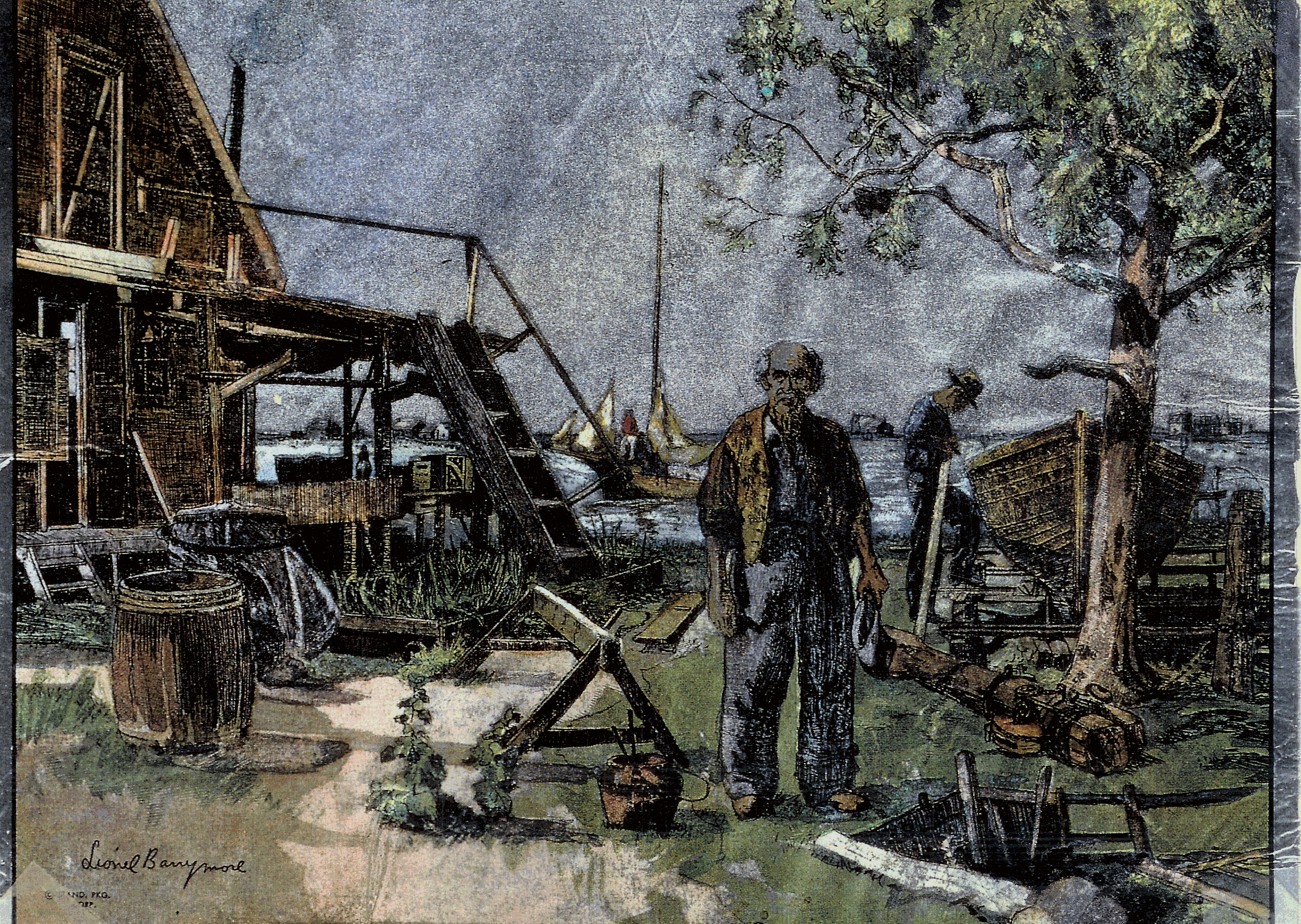
Dad and his cabin at Point Mugu, as drawn by Lionel Barrymore
Starting even before my memory, Dad always lived next door to us. For that reason, we had almost daily contact with him. He taught us all sorts of things, probably each of us according to what we wanted to learn. Some of these lessons applied to life in general, though we didnít know that at the time. "Trim the ship" meant that we should locate ourselves so that the boat was level in the water. Itís easier to steer a strait course, in a boat or through life, if your vessel is not leaning to one side. When rowing a boat sitting down, Dad admonished us to "Take a Stern Site", or line up a couple of objects in back of the boat, and row straight away from them. Isnít it important to know where you are coming from, in order to reach where you want to go? Dad taught us to use carpenter tools. Keeping these tools, and our minds, sharp was paramount to making our work, and our lives easier, and neater. Straight, square, plumb and level applies equally to carpentry and to how we live our lives, and how we treat other people. We learned how to splice ropes, tie knots and hitches, and rig pulleys`. How important is this? Well, isnít it usually our own rope that ensnares us?
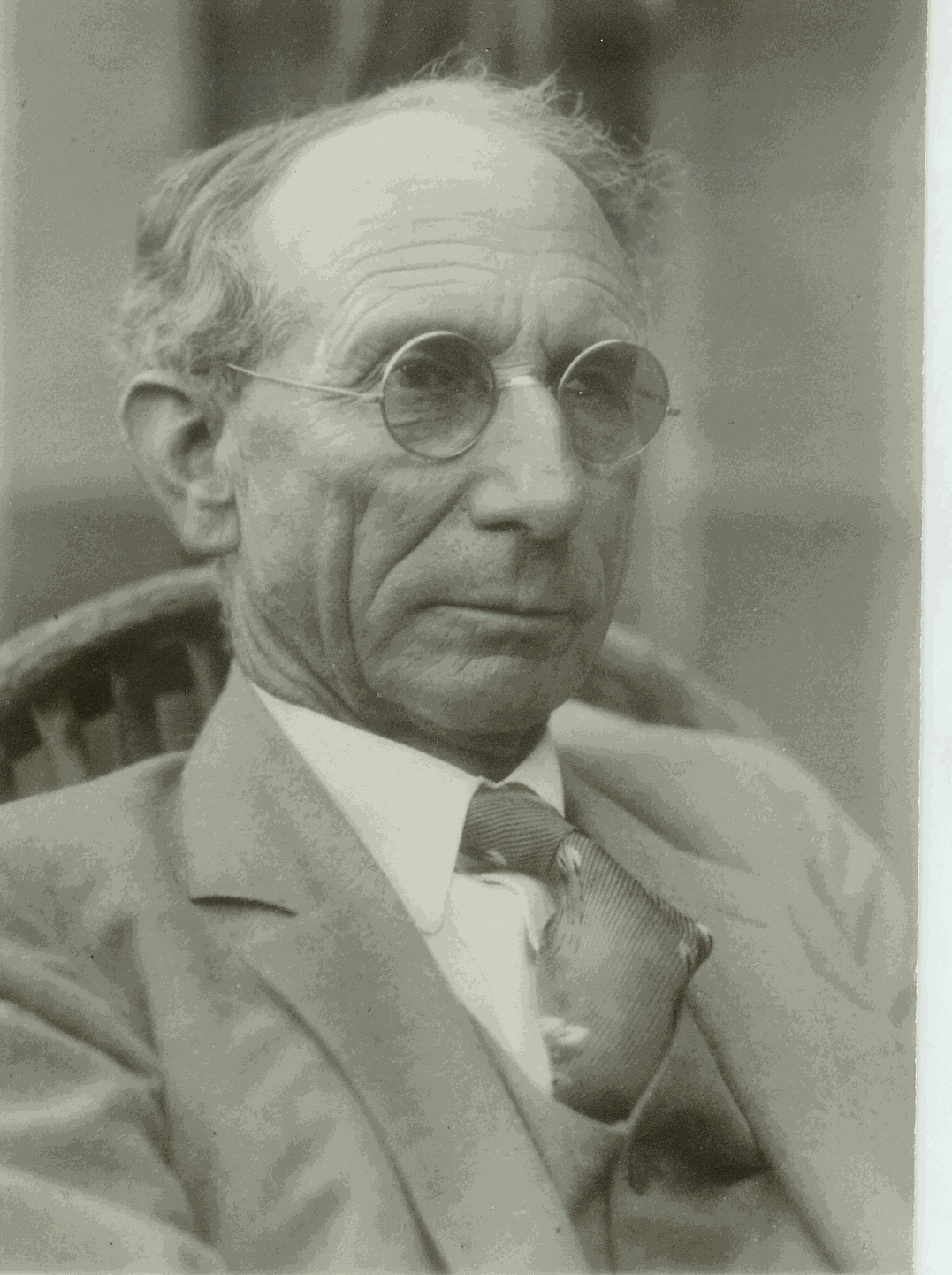
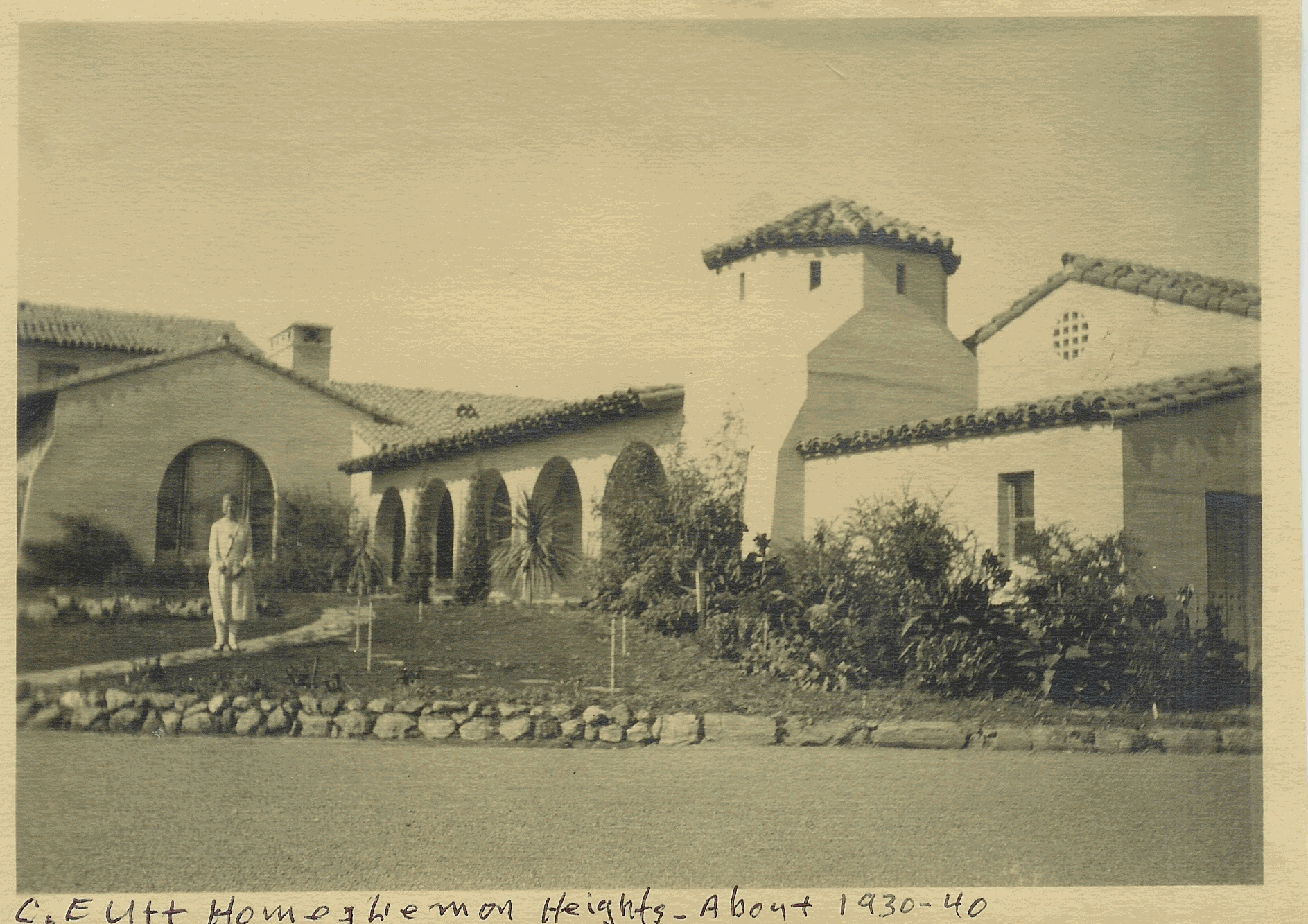
C.E. Utt, and his home on Lemon Heights.
Lemon
Heights, by the way, was another project carried out by Utt Development Co.
It was all planted to oranges, lemons and avocados. As parcels were sold, Houses
were built.
Grampa Utt, on the other hand, was this sort of eccentric man that popped in and out of our lives, never staying more than a few minutes, or an hour. When we saw him driving into the yard, one of us always rushed to find Dorothy, so that she could get some water on the stove. Grampa never drank anything but hot water. He felt it was healthier for him. I donít think I ever heard Grampa call me by my name. I was just ĎBoy", as were all his grandsons.
Grampa always wore a tailored suit, white shirt and tie. Of course, in those days a suit always had a vest with it. I think his wardrobe consisted of two suits, one that he wore every day, and one that he wore when he went to church on Sunday. His tailor in Santa Ana made a new suit for him every year or two, from the exact same material and color, a sort of blue grey. I have pictures of him spanning thirty or forty years, and they are all the same. After thirty days on horseback in the mountains of Sinaloa and Durango, unshaven, but suit, white shirt and tie. The three weeks I spent with him in the San Pedro Martir Mountains, suit, white shirt and tie. On a beach in Mexico, up to his knees in water, suit white shirt and tie. On several ranches, either helping with the irrigation, or supervising, suit, white shirt and tie. I do have one picture of Grampa wearing a very baggy pair of Leviís, taken in Baja. I presume that something catastrophic happened to his trousers, and he had to borrow the Leviís from someone else, someone much larger than him!
Before he got his first automobile, Grampa rode his bicycle as far as Santa Barbara and Ojai. Sometimes he and my grandmother took the train to Santa Barbara, taking their bikes with them. She would come home on the train, and he stayed to explore around Ventura County. His first land purchase in the County was 200 acres in Santa Rosa Valley. He developed this land into citrus and avocados, and then sold it in smaller parcels. He said it was a good learning experience, but he didnít make much money from it. I think that Reiter Bros, where our son Gerry works, is farming some of that land to berries. What goes around comes around! Also, I sold a tractor to the owner of one of these ranches many years ago. He remembered my grandfather.
His second purchase was 512 acres in Simi Valley, in 1924. He expected his partners to join him in developing this property, but they were not interested. It was then that he approached Dad and Tom, to see if they were interested. They sold all their assets in Los Mochis, Mexico and bought into the ranch. A Corporation was formed, with Tom owning half of the shares, Dad and Grampa owned ľ each. So now the Grandfathers were partners!
It must have been in the late 1920ís that the Utt Development Co. purchased 600 acres in the Oxnard area. This land was somewhat alkaline, so tile drain pipes were laid about five feet deep, in rows about twenty feet apart. These tile lines drained into a larger pipe that drained into Revlon Slew, which drained to the ocean. The land was then flooded with fresh well water. As the water penetrated, it carried the salt down into the tile drains. Iím not sure, but I suspect that this process took most of a year to clean the soil. The entire ranch was planted to Lemons.
This drainage process was also used on 100 acres, or more, of the Sinaloa Ranch, in Simi.
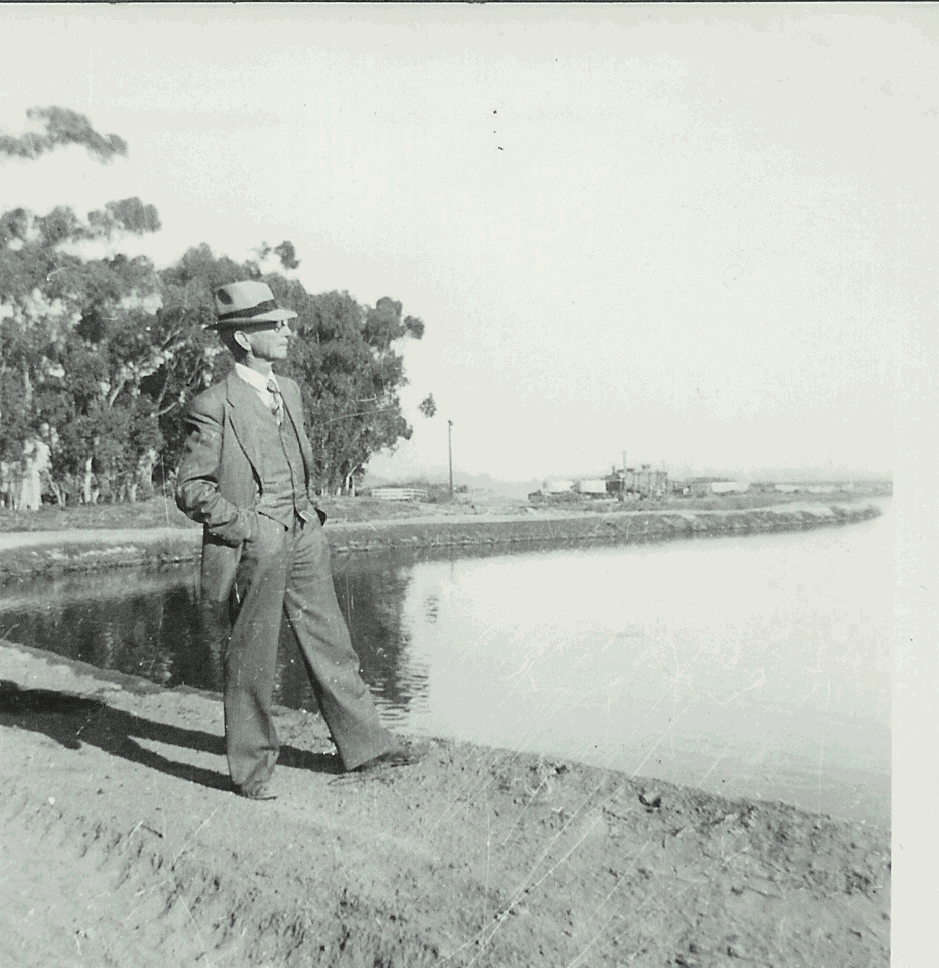
This leaching pond happens to be on the Mugu Ranch
During this same time frame, Grampa bought 800 acres in the west end of San Fernando Valley. I donít know many details about this project, but it must have been in his name, rather than Utt Development Co. The plan was to plant all, or most of it to Walnuts. What I know for sure is that as the Great Depression reached the West Coast, Grampa found himself a million dollars in debt, and no one had any money to buy the property. In order to meet these obligations, he had to liquidate many of his assets. He sold the Utt Juice Co. to my Uncle Arcie Schellhouse. He sold all his interest in the San Joaquin Fruit and Investment Co. to James Irvine. That meant that he no longer had a financial interest in the company that bore his name-Utt Development Co. His family was quite upset that his partners, Stevens and Irvine, did not take any responsibility for the Walnut Acres disaster. I canít comment on that, because I donít know if they had any financial interest in the property. What I do know is that Grampa never seemed to carry a grudge. He never said anything bad about his former partners. In fact I donít think he ever said anything bad about anyone.

Grampa
Utt inspecting a crop of Chile peppers on the Mugu Ranch,
with his ranch foreman, Albert Debushere.
Sometime in the late thirties he bought several hundred acres of land closer to Point Mugu. This land also had to be drained to get rid of the salt. As far as I know, he never planted any of this land to orchards, only row crops. While this ranch was under development, Grampa lived in what we called a "Tankhouse". There was a large water tank, raised about fifteen feet off the ground, supported by a wooden structure. This structure was closed in, to form a very small living space. It seemed so strange to me that even though he owned a mansion on Lemon Heights, he was happy to spend most of his time in this tiny house, by himself. I guess that tells us something about his dedication to whatever project he was working on.
When WW 2 started, the U.S Navy bought most of this property for the Naval Base at Point Mugu. The remaining 90 acres was eventually sold to Albert Debushere, who had worked for Grampa for many years.
I regret not having a closer relationship with Grampa Utt. I have come to realize that he was a remarkably intelligent man. I use Grampa as an example of the difference between a dreamer and a visionary. All of us have dreams of doing great things, but most of us find excuses for not acting on those dreams. Grampa dreamed, and visualized how to act on those dreams. He was not always successful, but he never quit trying!
Grampa did not write much about his own personal life, but a few lines from what he did write tell us all we need to know. Referring to when he was six years old; "Left much to myself, I was baffled by the wonderful world of which I knew so little. My horizons were narrow, perhaps a quarter of a mile to where the ridges met the sky. There was God overhead, who upheld all things, and there were Papa and Mama, His vice-regents, who upheld me. But I could not understand it all, nor can I now."
Written at about age 80, "I have helped roll back the wilderness, water the thirsty land, and cause wealth and beauty to grow where none grew before. I have made and lost a large fortune, yet I am not poor. I have good health, my children and grandchildren surround me, and my great-grandchildren are appearing. I have many good friends. I covet no manís property or position. I envy no man, and hate none. I am provincial, and think I live in the best place in the world, and among the best people". Wow, I should be so poetic! LR
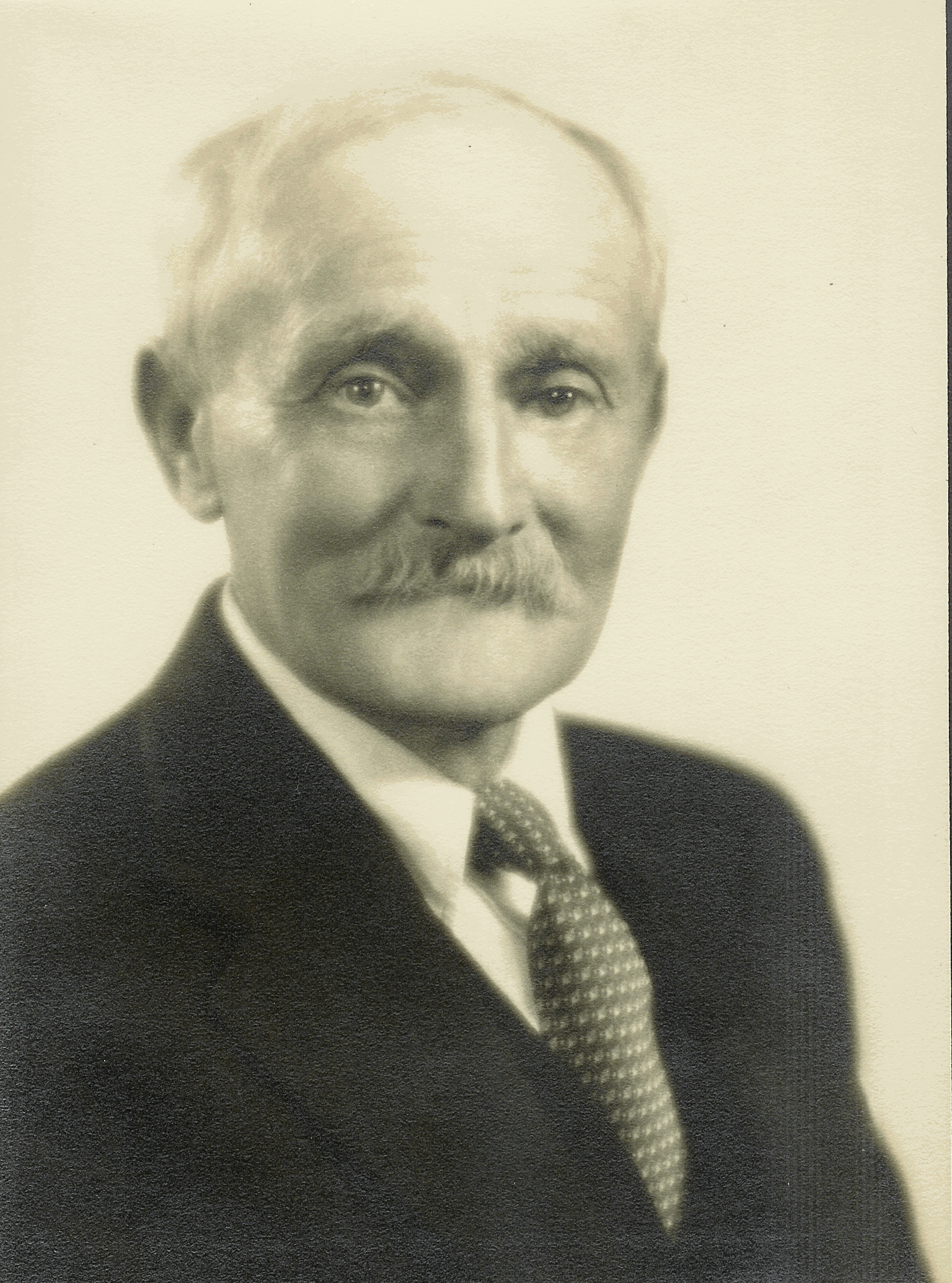
Dad, about 1936

Dad with his accordion, and Merilie
Dad was always with us on trips to Mexico, and he never left home without his accordion. There was always music and singing around the campfire in the evening. And, of course, there was always fishing. I can remember that he always carried a compass with him, at sea or in the desert! It was from him that I first knew of Magnetic Declination. He explained that magnetic North and True North are not the same thing. Memory tells me that in southern California True North is about 13 degrees West of Magnetic North. How could I have gone through life without that knowledge? Small wonder that so many people canít seem to navigate through life very well!
Itís interesting to me that these two men from vastly different backgrounds, with vastly different personalities and abilities, became such good friends. Dad was raised in a relatively affluent family, in a very civilized world. Grampa was raised on the frontier, in a family that struggled just to make ends meet, and where he had no playmates. They both became farmers, but Grampa was inclined to take on huge projects that required huge investments, while Dad started small, and only expanded as the finances permitted. Dad had the ability to fix anything that could possibly be fixed with wood or rope. Grampa was not handy with tools of any kind. Two examples come to mind. In a story about San Quintin, I described how Dad repaired our boat trailer with nothing but rope and a small tree. My cousin, John Deaver told me about one of his trips to Baja with Grampa. The model A Ford broke down about 15 miles north of San Quintin. Grampa sent John, on foot, to San Quintin to find a mechanic that could fix the problem. I think Grampaís "Survival Kit" consisted of a folding chair, and a pot to heat water, and then wait for someone to come by and help!
Both of them certainly were always ready for the next adventure!
I took both of them for granted at the time. Looking back, however, I realize that they were both rather remarkable, and I am a better person for having known them!
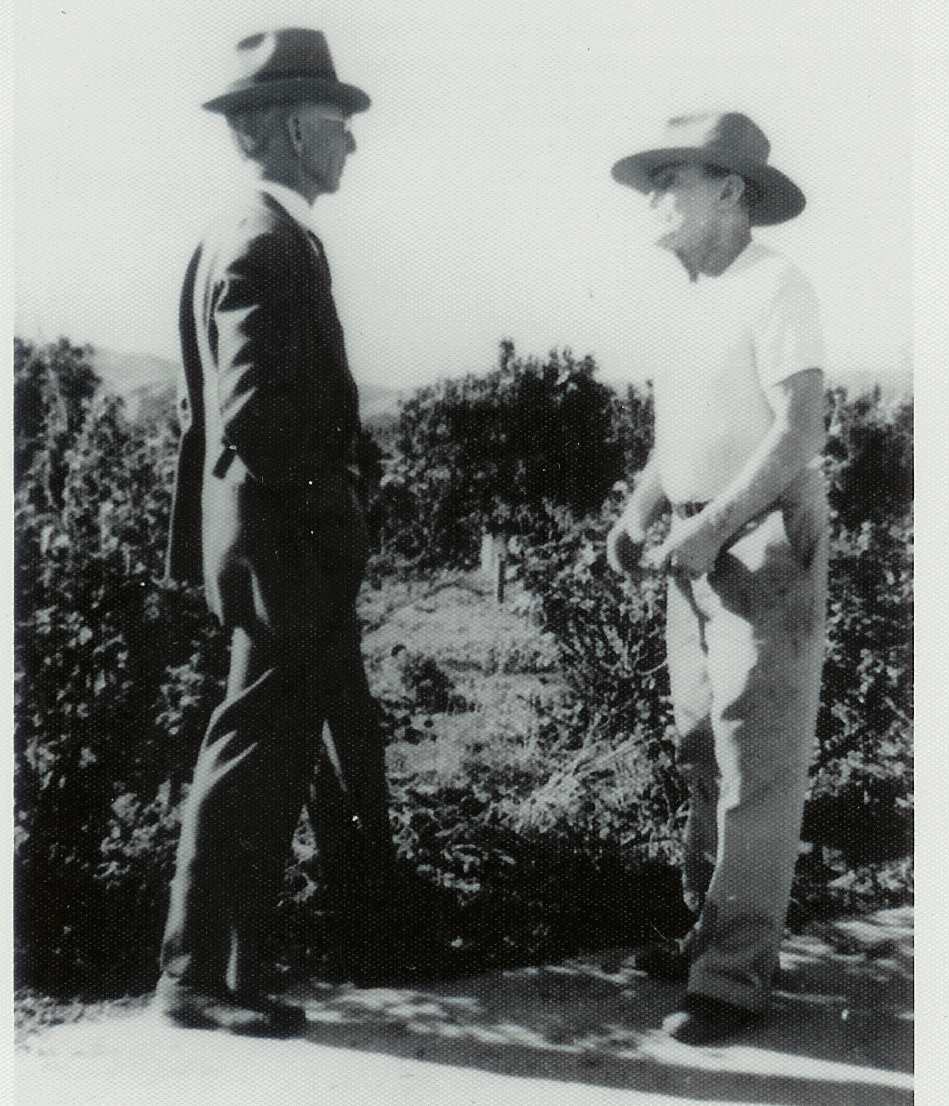
Do you suppose the Grandfathers are discussing the crops, or planning a new adventure?
Return to the Short Stories and Trips Page